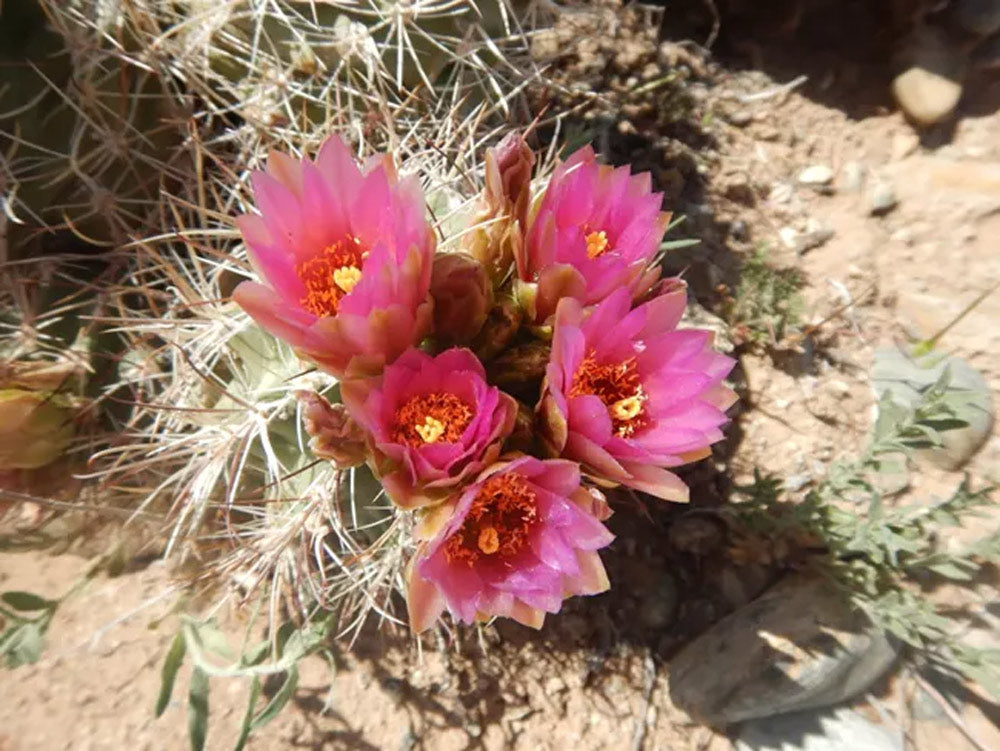Rare New Mexico Cactus Faces Extinction as Oil Drilling Pressures Mount
Matthew Russell
In the high desert of northwestern New Mexico, the small but resilient Clover’s cactus faces a fight for survival. Found only in the geologically unique Nacimiento Formation in Rio Arriba, Sandoval, and San Juan counties, this rare plant, adorned with purple blooms, has become the unlikely focus of an environmental and legal struggle.
Conservationists say the cactus stands at the brink due to mounting threats from industrial activity and habitat disruption in the region, prompting recent legal action to push for federal protections under the Endangered Species Act.

Photo: Wikimedia Commons / James St. John, License: CC BY 2.0
Industrial Impact on a Fragile Habitat
The Nacimiento Formation holds both geological and ecological significance. Unfortunately, it is also rich in oil and gas deposits, making it a prime area for extraction. Conservationists argue that this has become the primary threat to Clover’s cactus, as the Bureau of Land Management (BLM) has opened significant portions of this area to energy companies. According to WildEarth Guardians, poor regulatory oversight has exacerbated these issues, with oil companies reportedly ignoring environmental protocols designed to protect sensitive plant life. They also claim that inadequate BLM record-keeping on transplanted cacti has made it difficult to track the survival rates of these plants.
Beyond oil and gas, other human activities further jeopardize the cactus. Off-road vehicles damage the soil, making it less hospitable for delicate flora, and grazing livestock frequently trample on plants, adding to the decline. Each of these disturbances fragments and erodes the cactus’s already limited habitat, pushing the species closer to extinction.
Photo: Wikimedia Commons / James St. John, License: CC BY 2.0
A Struggle for Federal Protection
In response to these mounting threats, the Center for Biological Diversity and WildEarth Guardians filed a lawsuit against the U.S. Fish and Wildlife Service (FWS) on October 31, 2024. They argue that the agency has failed to meet its legal obligations under the Endangered Species Act.
“These beautiful cactuses and river-dwelling fish needed endangered species protections yesterday,” reads a press release from the Center for Biological Diversity.
Back in 2020, both conservation groups submitted petitions for FWS to consider listing Clover’s cactus and the Rio Grande shiner, another threatened New Mexico species, under federal protection. By law, the FWS had a one-year window to determine whether listing was warranted, yet this deadline has now passed by over three years. A recent study suggests such delays are not uncommon; the FWS has taken an average of nine years to make listing determinations since the early 1990s, even though the legal timeframe is two years, reports Yahoo News.
A Last Stand for the Nacimiento Ecosystem
The cactus’s plight reflects a larger struggle within New Mexico’s ecosystems, where industrial expansion often clashes with environmental preservation. Advocates like Joanna Zhang of WildEarth Guardians argue that federal protections are essential for preserving this species and the broader Nacimiento Formation ecosystem.
“We’ve lost so many native species already,” Zhang told KRQE. “You want future generations to see this part of New Mexico’s natural heritage.”
Oil and gas development in the region could have long-lasting ecological consequences. Drilling operations disrupt soil and water systems, which are vital for species like the Clover’s cactus that depend on stability in arid conditions. Conservationists point out that once these habitats are disturbed, they are incredibly difficult to restore, with cacti often unable to recolonize degraded lands. Environmental groups argue that these plants, though small and inconspicuous, are integral to the biodiversity and health of the entire desert ecosystem.

Photo: National Park Service, License: Public Domain
What Comes Next?
If Clover’s cactus gains protection under the Endangered Species Act, oil and gas operations in the Nacimiento Formation would face stricter regulatory oversight. This could include establishing buffer zones to protect critical habitats or limiting vehicle access to sensitive areas. For now, the legal battle continues, with conservationists pushing FWS to prioritize the cactus’s protection.
The Fish and Wildlife Service has refrained from commenting on the case due to pending litigation, but the lawsuit marks a critical juncture. It highlights the pressing need for timely decisions on species facing extinction-level threats. The case of Clover’s cactus exemplifies the broader environmental challenges facing New Mexico, where oil-rich lands overlap with fragile ecosystems.
Conservationists hope this lawsuit will set a precedent for future protections and renew attention on the delicate balance between energy development and conservation.
Click below to take action for the Clover’s cactus!


